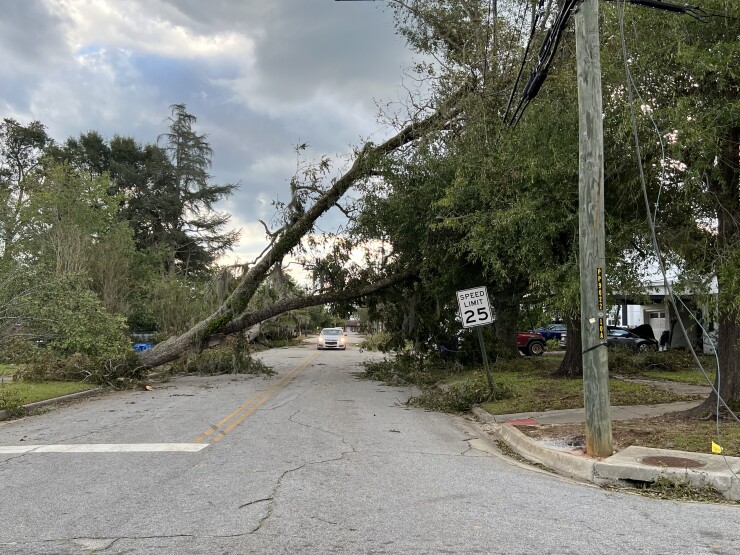Reopening a bank's branches and restoring connectivity
It is also a technological ordeal.
After a storm wreaks havoc on cities and states, power lines and cellular service may be down. Generators, fuel and batteries fly off the shelves. For a bank, that means its buildings are vulnerable and operations may grind to a halt.
The $2 billion-asset bank has 25 branches largely spread across
Only three branches had power that day. One of Queensborough's two operations centers was running on a generator. There was no cell service in any branch or center.
"We've never had that as long as I've been in banking," said Kirk.
Some employees couldn't come to work because trees were draped over their cars or had toppled onto their homes.
"It was a scary situation," said Kirk.
Financial institutions across the U.S. face similar predicaments
Banks in the hurricane's path are focused on finding employees and restarting operations. Those that do business in Western North Carolina are facing an especially grueling recovery.
The first, Kirk said wryly, is to not always believe the weatherman.
"Helene formed fast," she said. "We had business continuity calls prior to the hurricane but we didn't think we had anything to prepare for because it was not supposed to hit our footprint."
She plans to have a conversation about generators and maintaining ample fuel sources to keep them running. The generator for Queensborough's Louisville operations center was powered by natural gas, which the city turned off on September 28 because of a break in the line.
One of the keenest sources of worry at Queensborough once power went down was keeping the alarms that protect the branches well juiced. They had backup batteries but those are only designed for short interruptions, said Kirk. The bank was lucky in that Kirk had spent the night outside of the storm's path and could procure more batteries from her ATM and alarm vendor, Southern Bank Equipment & ATMs, as well as purchase two generators and 40 gallons of gas before driving to Louisville on Saturday. (The gas was intended first for her information technology team, including the chief technology officer, IT manager and IT analysts, who would be replacing alarm batteries every day and installing generators.) It took her four attempts to navigate to CEO William F. Easterlin III's house in Louisville on Saturday afternoon because fallen trees blocked the surrounding roads.
"The real problem for financial institutions was that it was a three-phase outage," said Beth Hausmann, CEO of Southern Bank Equipment. "Not only did they not have power, which impacted the network communications, but the cell service was completely destroyed as well. So there was no way for us or the bank to address some of the problems through technology."
Queensborough opened a handful of branches on September 30 and October 1 that had power and at least one circuit, or could be powered by generators. The branches running on generators limited activity to the drive-through. For branches with power and one circuit, Queensborough limited interactive teller machines to ATM-mode only as a precaution to preserve bandwidth for branch staff. The bank specified openings and closures on its website and on social media.
Kirk plans to explore Starlink satellite internet — "the hot topic since Helene" she said — because she and her team didn't plan for a scenario where cell service could be down for days on end. Here again, Queensborough was fortunate in that a few employees outside of the main footprint, as well as others with generators and internet service at home, could take over some tasks, such as responding to customer queries and processing files.
But a fourth takeaway is to remind employees to take company-issued laptops home with them before storms hit, including if they plan to temporarily relocate.
"We had some people who left town to stay in hotels but they didn't take the laptops with them," she said.
John McNair, president and CEO of the Community Bankers Association of Georgia, suggests banks outline disaster recovery plans with their regulators and third-party vendors. They should plan for worst case scenarios, such as ensuring generators, batteries and satellite internet are in place.
"Everyone in bank senior management needs to know what their roles and responsibilities are," he said.
He notes this kind of planning can be even easier to do at a small institution.
"Sometimes 'too small' is not a bad thing, especially in a disaster situation, because you can mobilize everyone fairly quickly," he pointed out.
Hausmann recommends that banks ensure that locations have an extra alarm battery and that employees know how to secure exterior doors that are normally controlled by electronic access.
Queensborough could open all branches by Monday, October 7, except for one that closed due to damage from an unrelated fire next door two days before. But Kirk acknowledged that the ability to operate was technological.
"There is also a human component," she said. "We still have employees dealing with total losses of homes and cars. There are lots of lingering impacts to us but we can function every day."







